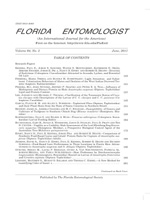FTA® technology is an approach designed to expedite and simplify the collection, preservation, storage, shipment, and recovery of nucleic acid from the storage matrix (Whatman Inc. 2002a). FTA® cards have been used and evaluated for DNA archiving of various biological sources (Moscoso et al. 2004; Harvey 2005). However, this method is expensive ($1.14/sample) and preparations can be elaborate, thus pushing researchers to devise alternative and cheaper methods for DNA preservation and storage (Owens & Szalanski 2005). Furthermore, in some cases, DNA retrieval from the FTA® cards is complex and requires highly selective conditions (Hide et al. 2003; Adams et al. 2008). Hence, some researchers have had to modify the protocols to retrieve DNA from the FTA® cards in their studies (Silva et al. 2004; Smith & Burgoyne 2004).
For termites, we have failed to obtain successful amplifications from the nucleic acid processed using any of the manufacturer-recommended procedures. Thus, we have developed a new combination of methods for DNA recovery from FTA® cards.
In our study, the gene of interest was a cellulase of termite origin in the glycoside hydrolase 9 superfamily These endo-β-1,4-glucanases are produced by the termite itself to digest cellulose. Seven species of termites from the family Termitidae were analyzed. Nasutitermes corniger (Motschulsky) was obtained from a laboratory culture collected from Dania Beach, Florida, USA. Nasutitermes sp., Macrotermes gilvus (Hagen), M. carbonarius (Hagen), Microcerotermes crassus Snyder, Microtermes pakistanicus Ashmead and Odontotermes sp. were all fresh specimens collected at Universiti Sains Malaysia, Pulau Pinang, Malaysia.
After collection, termite workers were rinsed with 85% EtOH to remove any surface debris and then allowed to air-dry for several minutes. Nucleic acid from the head capsules of 10 termite workers was released and preserved on the FTA® Plantsaver Card (Whatman Inc., Newton, MA) according to the manufacturer's protocol. Only termite heads were used to avoid sample contamination by DNA of resident gut microorganisms.
Using a sterile blade and forceps to prevent contamination, we excised a 1-cm2 piece containing dried nucleic acid extract from the FTA® card sample area and placed it in a 1.5-mL microcentrifuge tube containing 300 µL TE (10 mM Tris-HCl, 1 mM EDTA, pH 8) as elution buffer. The tube was then vortexed for 20 s before storage in a refrigerator at 4°C for 1 h. Each hydrated strip of FTA® card was squeezed with sterile forceps to release as much nucleic acid as possible into the elution buffer before the strip was discarded. The eluate was then purified with the Wizard® DNA Clean-Up System (Promega Corp., Madison, WI) following the manufacturer's procedure. As a negative control, a similar strip of FTA® card containing no sample was processed in the same manner to ascertain that the FTA® card alone did not yield positive results.
PCR was performed with specifically-designed endo-β-1,4-glucanase primers NTf3 (Tokuda et al. 1999) and NTr7 (Tokuda et al. 2004). Amplifications were conducted in 50 µL final reaction volumes, each containing standard PCR Buffer with 1.5 mM MgCl2 (Innis & Gelfand 1990), 2 µL DNA template, 50 ng of each primer, 125 µM of each dNTP and 1 U EconoTaq DNA polymerase (Lucigen Corp., Middleton, WI). Apart from the standard positive control DNA (NC-Q) extracted with DNeasy® Blood & Tissue Kit, an additional positive control (1 µL NC-Q + 1 µL FTA® negative control) was performed to dismiss the possibility of inhibition solely by FTA® cards. The primers used for PCR are available as supplemental information. The temperature profile for the first cycle was 94°C for 2 min, 52°C for 2 min, and 72°C for 3 min. For the remaining 44 cycles, the temperature profile was 94°C for 1 min, 52°C for 2 min, and 72°C for 3 min.
The endo-β-1,4-glucanase form 7 species of higher termites was successfully amplified from the DNA retrieved from the FTA® card, as determined by electrophoresis of PCR products through 1% agarose gels and visualization of products by UV transillumination after staining with ethidium bromide (Fig. 1). Aliquots (1 µL) of purified PCR products were quantified by comparison with serial dilutions of uncut lambda DNA (Promega) in 1% agarose gels (Fig. 2) and sequenced.
Fig. 1.
Visualization of endo-β-1,4-glucanase amplification from 7 termitid species with 1% agarose gel electrophoresis of DNA retrieved by our recovery method.

Our DNA retrieval method offers a few advantages over the processing method recommended by the manufacturer. For example, the latter's standard process necessitates the use of FTA® Purification Reagent (Whatman Inc., Newton, MA; $232.18), TE buffer (10 mM TrisHCl, 0.1 mM EDTA, pH 8) and Harris Micro Punches ($312.88) (or Harris Uni-Core Punches; $95.84). Our processing requires none of these, only the Wizard® DNA Clean-Up System ($1.38/prep) instead. The genomic DNA elution by a room temperature pH method (Whatman Inc. 2002b) is similar in concept to our method, but requires previous washing with the FTA® Purification Reagent, and the added use of 2 different solutions; namely 0.1 N NaOH, 0.3 mM EDTA (pH 13), and 0.1 M TrisHCl (pH 7). In addition, sample disc size is a critical factor because insufficient DNA affects amplification while excessive DNA may cause inhibition. However, despite these considerations, neither the 1.2-mm, 2.0-mm nor the 3.0-mm diameter discs with the manufacturer's method has ever produced successful amplification of endo-β-1,4-glucanase in our experience.
SUMMARY
In conclusion, we report an improved method for extraction and purification of termite nucleic acid from the FTA® Plantsaver Card (Whatman), which involves elution with TE buffer (pH 8) and purification with Wizard® DNA Clean-Up System (Promega). Our DNA recovery protocol requires less material, equipment, preparation, and manipulation, and reduces processing time, costs and chances for contamination compared with the manufacturer-recommended FTA® purification protocol. Most important, in relation to our study, it has been consistently effective in obtaining termite nucleic acid permitting further DNA analysis when all other methods have failed.






